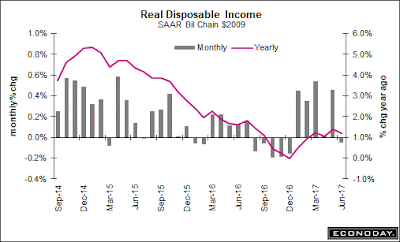Financial FAQs
As congress now pivots to the debate on tax reform—when and if they can agree on raising the debt ceiling—why is a lower corporate tax rate part of the proposal? The federal budget deficit can’t decline unless congress raises tax rates to 1970's level, when budget deficits were comparatively minuscule.
The total budget deficit in 1970 was $12.7 billion, or just 0.3 percent of GDP, vs. $580 billion and 3 percent today. The 1970 effective corporate tax rate on capital income was 42.0 percent, vs. 35 percent today. So any corporate tax cut will only grow the deficit, without benefiting consumers and job seekers.
This is while corporate profits rose $73 billion in the revised Q2 GDP growth rate; which has risen to 3 percent from Q1’s 2.1 percent rate. It was a good GDP number, as consumer spending increased 3.3 percent and business investment increased almost 9 percent with almost no inflation.
The proposed House bill wants to reduce the maximum corporate tax rate from 35 to 20 percent. But why, when as I said in a prior column, corporations already pay much less than the actual tax rate? Maybe this will change, but corporations have been using their record profits to buy back stock and enhance executive pay, rather than hire more workers, so that there are now 6 million job vacancies, according to the Commerce Department’s JOLTS report.
They have re-purchased so much stock that a Credit Suisse report released in March titled “The Incredible Shrinking Universe of U.S. Stocks,” says between 1996 and 2016, the number of publicly-listed stocks in the U.S. fell by roughly 50 percent — from more than 7,300 to fewer than 3,600 — while rising about 50 percent in other developed nations.
Not all of it is from stock buybacks, as there have been a large number of corporations either merging, or taken private in buyouts so that the number of listed companies has also declined almost 50 percent since 1996.
Why do corporations and their Republican lobbyists keep pushing for lower taxes? They say it will create more jobs. But, alas, that isn’t shown by the record. An excellent New York Times Op-ed by Sarah Anderson at the Institute for Policy Studies points out that many corporations create very few jobs with those profits.
She reports on 92 public-held American corporations between 2008-15 that pay less than 20 percent in taxes. They had a median job growth rate of 1 percent vs. 6 percent for all private sector corporations during that time.
And 48 of those companies actually cut 438,000 jobs, while their chief executives’ pay last year averaged nearly $15 million, compared with the $13 million average for all S&P 500 companies.
Then why not have congress push corporations to fill more of the 6 million job openings, which could expand their markets, increase profits and help to pay down our enormous public debt, rather than continue to fill their own pockets?
Harlan Green © 2017
Follow Harlan Green on Twitter: https://twitter.com/HarlanGreen
















